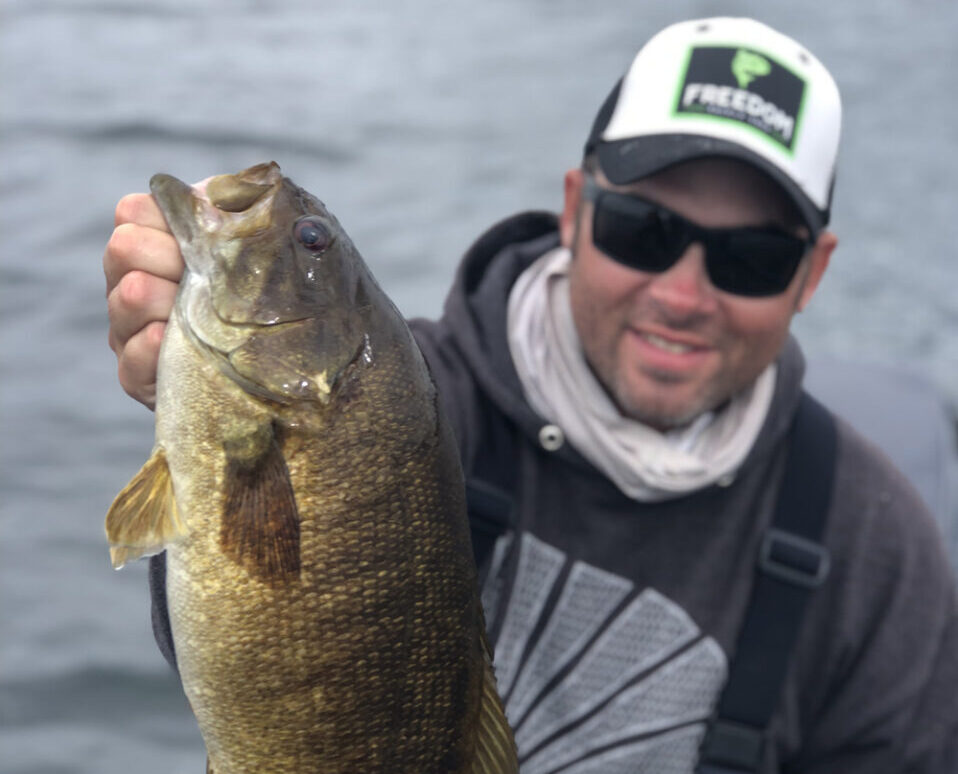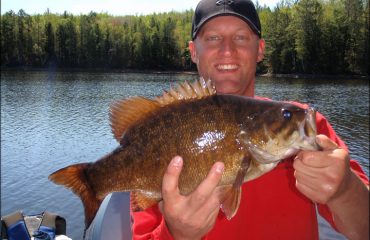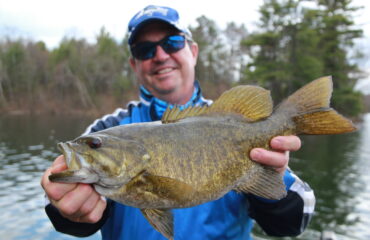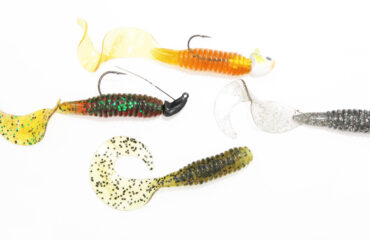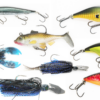Smallmouths the Northwoods Way
“Andrew, what’s your favorite lure of all-time for catching smallmouths?” my readers and customers most frequently ask.
“Whatever puts them into the boat for me,” is my typical answer.
I know, so clique.
Most teachers, coaches, or instructors tend to play favorites in order to succeed. But I don’t. With thousands of lures to pick and choose from within my tackle shop of a boat, they are nothing more than tools for the job.
The secrets to catching big smallmouths from the inland fisheries revolves around a lot of variables that lures and other material objects will never rival.
Smallmouth Secrets
Most anglers will play to their strengths. Mine is knowing my subjects. Additionally, I’m also good at identifying the lay of the lake, and locations. I also pay attention to detail. Strategy-wise, my strength is meticulously working tubes and other jig baits along the bottom, and covering water with long-distance casting strategies with paddletails and swimbaits.
Most days, my favorite paddletail flutters and kicks through the water column, vulnerably swimming to pique the interest of passer-by smallmouths. “Eat me!” it dares them to. Suddenly, the rod jolts – the tell-tale thump of smallmouth happens in mid-retrieve, without any notice. You get an adrenaline kick, and jack that fish with a hookset. The battle with a big brown grouper is on.
Pound for pound, the battle with a 5-plus pound smallmouth is far more exciting to me than any other freshwater gamefish. Its powerful runs, leaping ability, and reluctance to come near the boat is why I am obsessively captivated by them.
Monster smallmouths are the fish of legends. Catching them is the ultimate challenge for any bass angler due to difficulty of their nature, and that only a select few waters are ever capable of consistently growing them to huge sizes. Bass get trashed by other angler sectors for how unintelligent they are, and their ease of catching. Little do they know, the biggest fish available in the lake are far from easy to capture.
Here’s how I do it – the Northwoods way.
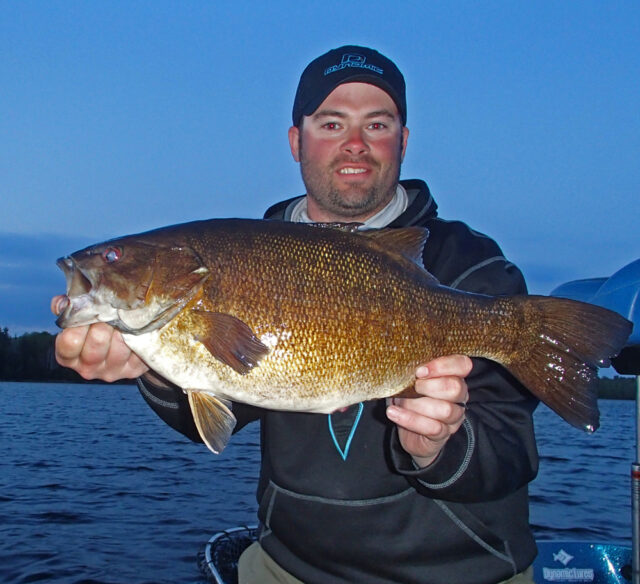
^Throughout the season, you will want to prioritize fishing on trophy-regulated waters where average size fish could be 18-20 inches length.
Identify Trophy Waters
You should mostly want to fish waters that have a good recent history of producing fish achieving 5-pounds. Nowadays, a good number of inland waters throughout Minnesota, Wisconsin, and Michigan that are managed exclusively for big fish in mind, having implemented special management regulations to maintain their lower population densities. While many more lakes commonly grow numbers of 3 to 4 pounders, very rarely do these action fisheries produce a top end fish surpassing a 5 to 6-pound weight.
State DNR databases can provide lists and lake survey records of the best trophy bass lakes in their states. Wisconsin and Michigan do a good job of this, publishing their data online.
Waters with public access are managed for different purposes and fishery goals. Trophy smallmouth fisheries are specifically managed under special regulations for big fish and to purposely maintain the lower population densities that are necessary in supporting them. On these types of lakes on my home waters of Wisconsin, average fish captured are 18 inches and better, but catch rates are far fewer in number. Bass are not the dominant and most abundant gamefish in the lake like walleyes and other species could be. Their special regulations only exist for maintaining their low number, controlling aquatic invasive species, or helping better maintain populations of the other fish species.
As a result of this management strategy and philosophy, low density bass waters rarely ever produce numbers but will commonly grow monsters.
Most unique to trophy bass lakes is that historically every water I fish has areas that consistently produce big fish. Have the presence of mind that big fish spots exist on every lake. Their locations will be quietly revealed the more frequently you hunt.
Catching big smallmouths has no one size fits all pattern and strategy. Every specific fishery could require a unique bag of tricks. Having identified trophy capable waters and understanding them is always my first step to catching big fish.
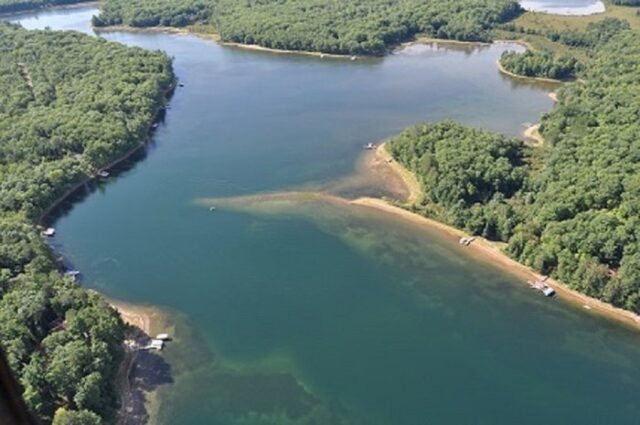
^ Smallmouths love and thrive in lakes with topography and several other unique features. This aerial shot showcases what I look for and what I want to see on the charts when it comes to exploring new lakes or finding fisheries.
Know Their Nature
Pursuing smallmouths throughout most of Wisconsin, one common characteristic leading to consistency and fishing success is that smallmouths are structure-oriented a lot like walleyes are. Across most lakes, you can expect smallmouth movements and locations to revolve around the lake’s available structure and topography. The more topography a lake has, the better it can be for hosting a good smallmouth fishery.
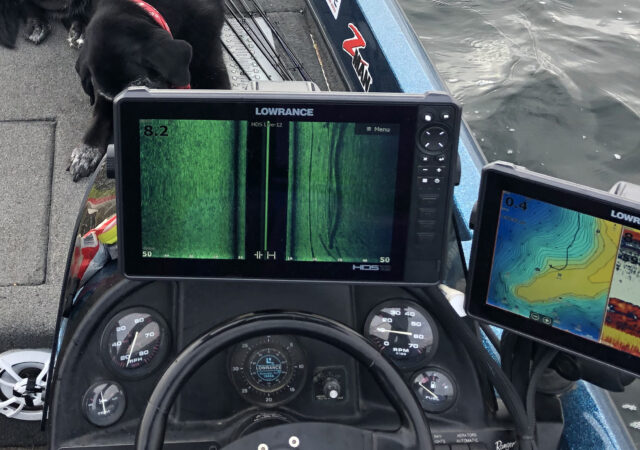
^ Smallmouths are structure oriented. My dual-screen spread illustrates how you should want to fish and position the boat.
Commonly, look for fish from 5-feet to 25-feet depending on the season. Smallmouths adapt well to everything the lake offers them, preferring bottom substrates of rock, sand, and boulder. They also favor unique bottom transitions, drop-offs, rock humps, cribs, sand grass, and other contour-influenced habitats providing them with the comforts of home. On some lakes, they are even weedline oriented like other gamefish species. Meanwhile on other waters, which offer smallmouths nothing but barren basins and open water, they roam and turn pelagic. The allure of forage species such as ciscoes, smelt, perch, and crayfish varieties will also draw them to specific areas too, and shape their seasonal feeding habits.
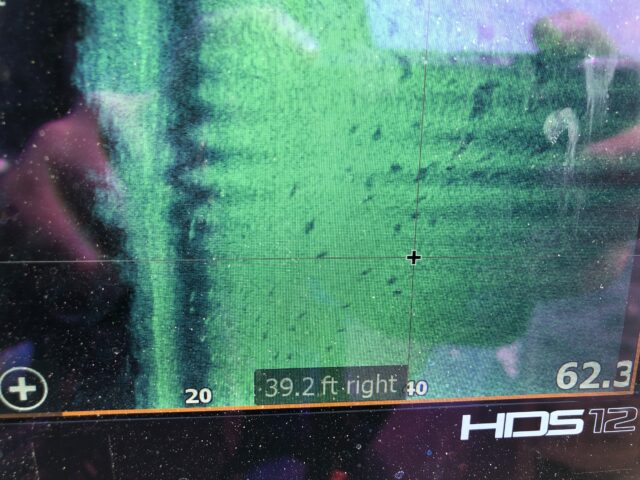
^ Packs of smallmouths found on side-imaging. This school was roaming off the edge of a sand grass hump in 20-ft of water.
As majority of the angling population hammers the near-shore regions of every lake, I predominantly rely on main-lake and offshore structure throughout the year. These fish are less pressured, but more in abundance I feel. They also tend to run larger in size. I depend upon my Lowrance HDS-Live units for finding them, and C-Map Reveal for aiding in my boat’s positioning and tracking.
Be mindful that if you can see smallmouths in clear water, they can see you. They have amazing vision and sensory organs. Their sensors can be of detriment if your fishing relies exclusively on live-imaging and forward-facing sonars. I have seen these fish spook and turn-off as a result of their high-powered frequencies. However you fish, be stealthy, and approach them from a distance. I know for certain this is why my boat’s long-cast approach and strategy with paddletails and other search lures works so well throughout the year, as we are targeting fish that are unable to detect us. When they don’t hold to structure, they roam. Your approach with these fish should likewise revolve around these tidbits.
Successful fishing is all about right time, right place. The right time and place to catch the biggest fish of the year for me is in May, late July through early August, and later in the year from mid-September through late October. The spring spawn, summer peak, September feeding, and late October wintering periods create vulnerabilities for smallmouths. Big fish are most apt to be feeding, schooling, or wintering. These periods are also when female bass will be at their heaviest weights.
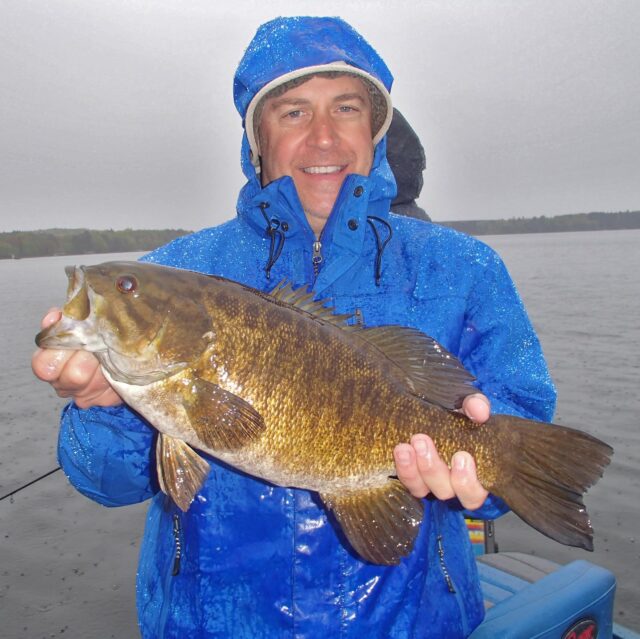
Of course, any time of the year can produce a trophy, too. My boat has captured big fish on random days, in non-peak seasons, and also on days when conditions would tell you otherwise. In my mind every day can have the potential for a big fish if you’re on the right waters!
Trophy smallmouth fishing is unlike anything else in bass fishing. You are casting into the lake’s abyss. Unless you are prioritizing the correct waters, most days will not produce a trophy. Some days will only produce a few bites. Others, maybe just one or none altogether. The way I want to fish each day is strenuous and is very much like muskie fishing.
The Process
Hooking up with a monster smallmouth is extraordinary. Land it successfully, the experience could be life-changing.
Hopefully, before you target smallmouths, you have the right equipment.
Many smallmouth anglers mistakenly fish with equipment that is too light and whippy to handle large fish. Light rods are unable to deliver powerful hook sets needed from afar and down deep. Big fish will control you, instead of you controlling them. Wimpy equipment will also exhaust these fish to death. Unless it’s brought up from the depths slowly, absolutely no bass should ever be played on your line for longer than 30 seconds length.
I fish with a diverse arsenal and artillery of St. Croix rods. For most jigging and casting strategies, I equip myself with a number of medium and medium-heavy fast action rods. St. Croix manufactures a bass rod for almost every kind of strategy imaginable. The Legend Tournament Bass, Victory, and Legend Elite series are my most oft-used rods.
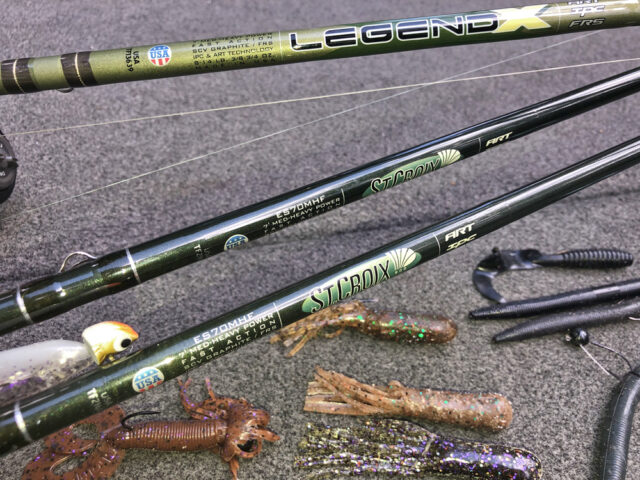
While the average angler shouldn’t need carry 20 to 30 rods in the boat, ideally you should want to consider an average of 5 to 10 setups for practical, all-purpose every-day use.
- Swimbaits (casting): Legend Tournament Bass Power Finesse (LTBC73MHXF), or Warhorse (LTBC75MHF). For spinning, seek a similar length and action.
- Crankbaits (casting): Legend Glass (LGC72MM)
- Jigging (spinning): Legend Tournament Bass Versatile (LTBS71MF), or Legend Elite (ES70MHF)
- Finesse (spinning): Victory Finesse (VTS71MF), or Max-Lite Weight (VTS73MLXF)
- Jerkbaits (spinning or casting): Victory Light Weight (VTS610MXF), or Mojo Bass Jig-N-Worm (MJC68MHF)
- All-Purpose (wildcard): Victory Max-Finesse (VTS71MHF)
Light lines provide stealth, but they are too delicate and prone to break-offs. Most line failure is a result of a poorly-tied leader knot. For main lines, I strongly advise 15-to-20-pound Cortland Masterbraid for most jigging and casting applications (black or moss green). Lighter sizes ranging from 5-to-12-pound (high vis yellow) are suitable for finesse fishing. Additionally, 10-to-15-pound fluorocarbon lines are excellent for crankbaits and jerkbaits, and copolymer lines in same sizes too for spinnerbaits and topwaters. For leader knot attachments, I rely on the RP (Royal Polaris) knot. This is the quickest and cleanest knot to tie – your rod’s micro guides will thank you for tying it.
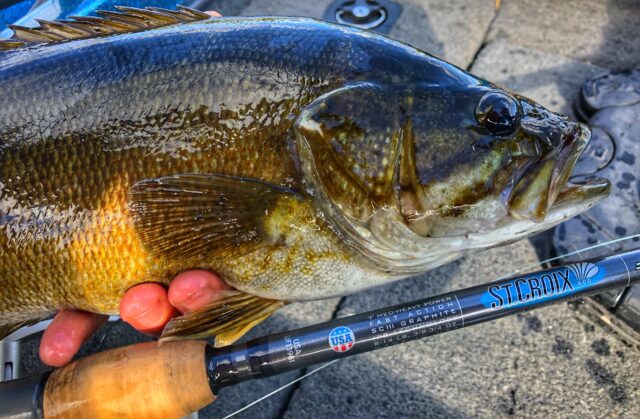
Renewable Resources
Once captured, have a plan for handling and quickly releasing fish. I continue to be appalled by the number of anglers who mishandle them, dropping frisky fish to the boat floor, and flopping them throughout the boat. It is important for the fishery’s future to handle these delicate fish quickly, correctly, and with care.
If you’ve read prior articles, seen my photos, or hired me for trips before, you’re aware that I use a rubberized Frabill landing net. Its thick, rubber bag is kind to their fins and slime coat. Also, the bag is deep and large enough to use as a boatside holding pen for big bass. Therefore, while the boat is in chaos or we’re prepping for a measurement and photos, that fish can remain swimming and breathing in the water without any stress or issue. During the spawning season, I try to avoid using a net altogether – hand-landing them instead.
Minimize the time from when the fish is landed to when it swims away. I strive for a time limit of 20 to 30 seconds. The only 5 to 10-seconds that a big fish should be out of the water for is for a photo or quick video. This practice helps assure lively release.
The most important aspect of my boat set-up and fishing system is having a camera system set-up in the boat. When I don’t have customers or partners with me, I mount a few self-timer camera and GoPro Hero-10 set-ups throughout my boat. One camera is mounted atop my steering console, and another gets attached to the front pedestal seat.
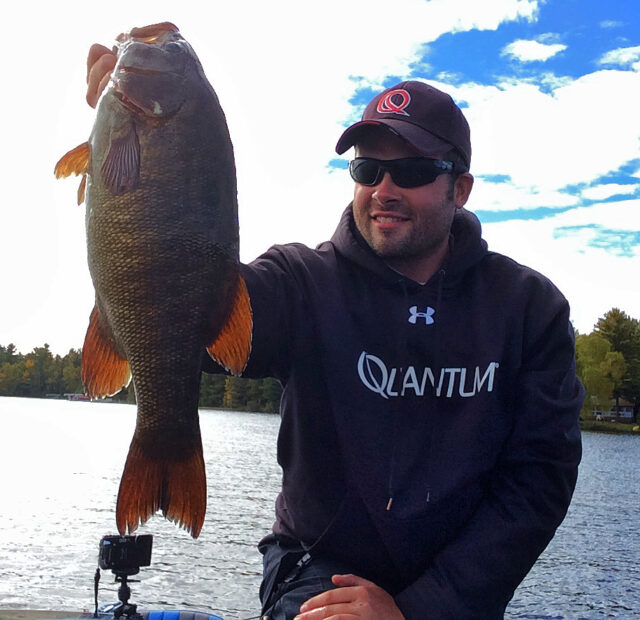
Have the proper release tools. These should consist of pliers, hook cutters, bolt cutters, and a Baker hook extractor tool. Most big smallmouths are hooked cleanly in the jaw, so surgeries are rare. Smaller fish on the other hand are notorious for suicidal feeding and gut hookings. There is no solution to this other than maintaining a taught line to detect bites, and setting the hook instantaneously. If by chance a smallmouth has taken a bait deep, or is bleeding, prioritize immediate and boat-side release over a photo. Ultimately you want to avoid a non-releasable situation.
Presently, no other demographic in fishing is growing as exponentially and aggressively as smallmouth fishing. With increased popularity and pressure, angling hours, and water traffic, we must police ourselves to assure our actions aren’t negatively impacting the fisheries, and our handling practices don’t lead to delayed mortality.
When she’s ready to go, be extra delicate. Big smallmouths need more oxygen, and require extra care at times to fully regain their strength in order to swim away. There is no appropriate reason for these fish to be livewelled instead, like some do. When her tail tenses up, you’ll know she’s ready to burst off.
Big smallmouths in my neck of the woods are caught and released repeatedly. These fish are capable of achieving life spans of 20 to 30 years on some waters. If you need further proof, the same 7-pounder I captured twice in 6 months during the 2018 season was previously captured and aged in a DNR survey. At the time of my capture, she was a 25+ year old specimen. The trophy smallmouth bass we pursue are old and irreplaceable – the most valuable members of the population. The availability of these big fish is what drives YOU to my waters!
Take care of the fishery, and it’ll take care of you. Fish wisely because these are wise, old fish. That’s smallmouth fishing the Northwoods way.
Andrew Ragas splits time between the Chicago area and Wisconsin’s Northwoods. Based in Minocqua, WI, he specializes in trophy bass fishing and offers guided trips from May thru October. While big bass is the passion, he dabbles in multi-species as well. He may be visited online at www.northwoodsbass.com


